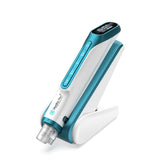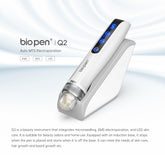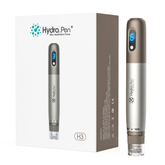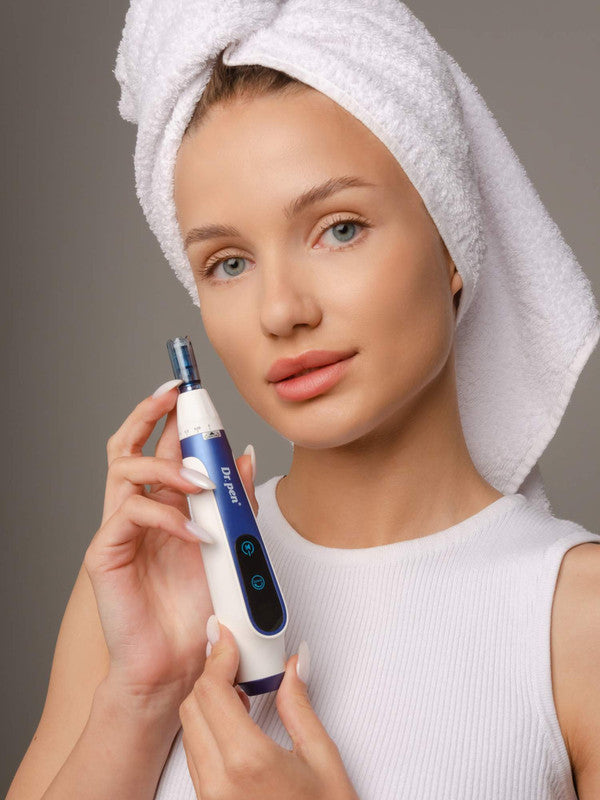So, you’ve decided that you want to start microneedling! We can’t wait for you to get started on this amazing skincare journey - the results can be truly amazing and we are here for you every step of the way on your journey.
Before you get started though, let’s double check a few things - because microneedling is a cosmeceutical procedure, there are contraindications and side effects to be aware of.
So, who can get microneedling?
Your safety is our highest priority (which is why all Dr. Pen microneedling pens are registered with the Store Register of Therapeutic Goods). Let’s break down some of the key considerations of microneedling.
WHAT MICRONEEDLING CAN HELP WITH
Microneedling is wonderful for anyone who wishes to restore vitality to their complexion, anyone who wishes to look younger and anyone who wishes to heal skin imperfections and fight the visible signs of ageing.
Microneedling can help with:
Reducing fine lines and wrinkles
Softening the appearance of enlarged pores
Reducing hyperpigmentation
Healing acne scarring and other scarring
Smoothing over stretch marks
Restoring hydration to the skin
Restoring tonal/textural irregularities
WHO SHOULD BE CAUTIOUS BEFORE MICRONEEDLING
Unfortunately, there are some conditions that will preclude individuals from safely performing microneedling, or will mean that microneedling will need to be cleared by your medical professional first.
Some of these conditions include:
Abnormal skin conditions
If you’ve got abnormal skin conditions (such as cold sores (Herpes Simplex virus), bruised skin, eczema, rosacea, contagious skin conditions, active acne, fungal infections, rashes or skin cancer), then you should take precaution and check with your medical professional before commencing any microneedling.
Skin conditions don’t necessarily mean that you will not be able to microneedle, but precaution must be taken to avoid triggering an inflammatory skin response that will worsen any of the above conditions, so please check with your doctor first.
Keloid scarring
If you’ve ever had keloid scarring (raised scarring), you should also check with your medical professional before microneedling.
Microneedling stimulates a trauma/healing response in the skin, so if your skin’s natural response is to produce a keloid scar, microneedling may trigger an undesirable response.
Medications
If you’re taking medications such as accutane, antibiotics, antidepressants, medications that cause photosensitivity or high blood pressure, please consult your medical professional before commencing microneedling.
Some medications will mean that you are unable to microneedle, others will simply mean that you can microneedle with caution under your doctor’s guidance. It’s crucial to double check this suitability first before you start microneedling.
Cosmetic treatments and surgeries
If you’re undergoing cosmetic treatments including chemical peels, laser, cosmetic surgery, filler injections, Botox or cosmetic surgery, it’s necessary to wait until your skin fully recovers before commencing microneedling.
Make sure to check with your medical professional before you start microneedling to make sure it will not interfere with any of your cosmetic procedure results.
Portrait of a young woman with clean flawless skin
Proper microneedling gives you a range of amazing anti-ageing benefits - and when care is taken to ensure that you’re suitable for microneedling, you can feel good about treating yourself to microneedling at home (and saving hundreds of dollars that you’d have to spend at the clinic every 4-6 weeks!).
Tip: Always ensure to carefully read through the instruction guide included with your Dr. Pen Store microneedling pen. It contains vital info to properly use your pen, as well as techniques and best practices to help you get the most out of your microneedling treatments.
WHAT ARE THE SIDE EFFECTS OF MICRONEEDLING?
After microneedling, your skin will be red/pink. You may experience some pinprick bleeding (known as petrichae) and your skin will be a little blotchy. We recommend microneedling when you’ll have time to relax at home without feeling self-conscious.
If you’re just about to head off to a big event, that’s not the time to try microneedling!
Your skin may also be a little swollen and you may experience some bruising, especially around areas of thin tissue (such as the delicate skin around the eyes or decolletage).
After microneedling, your skin also may feel a little rough to the touch for a few days and you may notice some visible marks on your skin, both caused by the microchannels created during microneedling.
Please note, the above listed side effects are harmless and all part of the skin’s healing process.
However, if at any point you’re concerned about the progression of your skin’s healing, or if you feel that you’re bleeding or bruised excessively, please speak to your medical professional.
HOW TO PROTECT YOUR SKIN AFTER MICRONEEDLING
Remember that microneedling triggers a trauma/healing response in the skin (which is what helps stimulate the production of collagen and elastin, which gives the beautiful anti-ageing and skin perfecting results that we are looking for!).
Thus, care should be taken for a short while following your microneedling treatment to help promote your skin’s proper healing.
The day after treatment, wash your face with a gentle cleanser and apply a nourishing moisturiser. Avoid products containing fragrances or active ingredients (vitamin C, A/Retinols), acids (lactic acid, AHA, BHA), scrubs or toners which may cause irritation.
Your skin may experience mild swelling, bruising, peeling and flaking. You can minimise these effects by keeping the skin moisturised, which will reduce shedding and alleviate tightness.
Avoid exercising, sweating excessively, swimming or applying makeup for 24 hours. You must apply a high protection sunscreen when going outdoors, and avoid prolonged sun exposure.
48 Hours After:
Optional: Begin to gently exfoliate the dry/flaking skin to help speed up the recovery process, and continue to hydrate the skin, morning and night.
Please note that this step is totally optional and if you choose to exfoliate to speed along the process, be sure not to exfoliate with any chemical or physical exfoliants, as both can irritate your skin as its healing.
Do not exfoliate if the skin feels sensitive - the flakiness and dryness of the skin will naturally subside.
3-5 Days Post-Treatment:
Continue to apply a high protection sunscreen daily and avoid direct and extended sunlight for up to 1-week post-needling.
Your skincare routine should focus on hydrating and moisturizing products, continuing to avoid active ingredients, acids, scrubs and toners.
7+ Days Post-Treatment:
You may return to your regular skincare routine.
What you can’t do after microneedling
After microneedling, you must be cautious to protect your skin from the harsh UV rays of the UK sun! A broad-spectrum sunscreen of at least SPF 50 is always crucial in England but after microneedling, it’s more crucial than ever.
Any resurfacing treatment (including microneedling) can make your skin more susceptible to hyperpigmentation when exposed to the sun, so you should limit your sun exposure following a microneedling treatment and wear sunscreen at all times.
If you do need to go outdoors, where possible wear a hat also to protect your freshly treated skin.
You’ll also want to ensure to use a mineral-based sunscreen to limit the chances of any skin sensitivity.
Immediately after microneedling, as your skin will be sensitive, it’s also important to consider the ingredients of any cosmetic products that you’re applying. Although you may be tempted to use foundation to cover any irritation, it’s best to let your skin breathe, if possible!
If you must use foundation, use a mineral-based powder that won’t clog your pores and will limit the chances of any adverse sensitivity reactions.
Before you get started though, let’s double check a few things - because microneedling is a cosmeceutical procedure, there are contraindications and side effects to be aware of.
So, who can get microneedling?
Your safety is our highest priority (which is why all Dr. Pen microneedling pens are registered with the Store Register of Therapeutic Goods). Let’s break down some of the key considerations of microneedling.
WHAT MICRONEEDLING CAN HELP WITH
Microneedling is wonderful for anyone who wishes to restore vitality to their complexion, anyone who wishes to look younger and anyone who wishes to heal skin imperfections and fight the visible signs of ageing.
Microneedling can help with:
Reducing fine lines and wrinkles
Softening the appearance of enlarged pores
Reducing hyperpigmentation
Healing acne scarring and other scarring
Smoothing over stretch marks
Restoring hydration to the skin
Restoring tonal/textural irregularities
WHO SHOULD BE CAUTIOUS BEFORE MICRONEEDLING
Unfortunately, there are some conditions that will preclude individuals from safely performing microneedling, or will mean that microneedling will need to be cleared by your medical professional first.
Some of these conditions include:
Abnormal skin conditions
If you’ve got abnormal skin conditions (such as cold sores (Herpes Simplex virus), bruised skin, eczema, rosacea, contagious skin conditions, active acne, fungal infections, rashes or skin cancer), then you should take precaution and check with your medical professional before commencing any microneedling.
Skin conditions don’t necessarily mean that you will not be able to microneedle, but precaution must be taken to avoid triggering an inflammatory skin response that will worsen any of the above conditions, so please check with your doctor first.
Keloid scarring
If you’ve ever had keloid scarring (raised scarring), you should also check with your medical professional before microneedling.
Microneedling stimulates a trauma/healing response in the skin, so if your skin’s natural response is to produce a keloid scar, microneedling may trigger an undesirable response.
Medications
If you’re taking medications such as accutane, antibiotics, antidepressants, medications that cause photosensitivity or high blood pressure, please consult your medical professional before commencing microneedling.
Some medications will mean that you are unable to microneedle, others will simply mean that you can microneedle with caution under your doctor’s guidance. It’s crucial to double check this suitability first before you start microneedling.
Cosmetic treatments and surgeries
If you’re undergoing cosmetic treatments including chemical peels, laser, cosmetic surgery, filler injections, Botox or cosmetic surgery, it’s necessary to wait until your skin fully recovers before commencing microneedling.
Make sure to check with your medical professional before you start microneedling to make sure it will not interfere with any of your cosmetic procedure results.
Portrait of a young woman with clean flawless skin
Proper microneedling gives you a range of amazing anti-ageing benefits - and when care is taken to ensure that you’re suitable for microneedling, you can feel good about treating yourself to microneedling at home (and saving hundreds of dollars that you’d have to spend at the clinic every 4-6 weeks!).
Tip: Always ensure to carefully read through the instruction guide included with your Dr. Pen Store microneedling pen. It contains vital info to properly use your pen, as well as techniques and best practices to help you get the most out of your microneedling treatments.
WHAT ARE THE SIDE EFFECTS OF MICRONEEDLING?
After microneedling, your skin will be red/pink. You may experience some pinprick bleeding (known as petrichae) and your skin will be a little blotchy. We recommend microneedling when you’ll have time to relax at home without feeling self-conscious.
If you’re just about to head off to a big event, that’s not the time to try microneedling!
Your skin may also be a little swollen and you may experience some bruising, especially around areas of thin tissue (such as the delicate skin around the eyes or decolletage).
After microneedling, your skin also may feel a little rough to the touch for a few days and you may notice some visible marks on your skin, both caused by the microchannels created during microneedling.
Please note, the above listed side effects are harmless and all part of the skin’s healing process.
However, if at any point you’re concerned about the progression of your skin’s healing, or if you feel that you’re bleeding or bruised excessively, please speak to your medical professional.
HOW TO PROTECT YOUR SKIN AFTER MICRONEEDLING
Remember that microneedling triggers a trauma/healing response in the skin (which is what helps stimulate the production of collagen and elastin, which gives the beautiful anti-ageing and skin perfecting results that we are looking for!).
Thus, care should be taken for a short while following your microneedling treatment to help promote your skin’s proper healing.
The day after treatment, wash your face with a gentle cleanser and apply a nourishing moisturiser. Avoid products containing fragrances or active ingredients (vitamin C, A/Retinols), acids (lactic acid, AHA, BHA), scrubs or toners which may cause irritation.
Your skin may experience mild swelling, bruising, peeling and flaking. You can minimise these effects by keeping the skin moisturised, which will reduce shedding and alleviate tightness.
Avoid exercising, sweating excessively, swimming or applying makeup for 24 hours. You must apply a high protection sunscreen when going outdoors, and avoid prolonged sun exposure.
48 Hours After:
Optional: Begin to gently exfoliate the dry/flaking skin to help speed up the recovery process, and continue to hydrate the skin, morning and night.
Please note that this step is totally optional and if you choose to exfoliate to speed along the process, be sure not to exfoliate with any chemical or physical exfoliants, as both can irritate your skin as its healing.
Do not exfoliate if the skin feels sensitive - the flakiness and dryness of the skin will naturally subside.
3-5 Days Post-Treatment:
Continue to apply a high protection sunscreen daily and avoid direct and extended sunlight for up to 1-week post-needling.
Your skincare routine should focus on hydrating and moisturizing products, continuing to avoid active ingredients, acids, scrubs and toners.
7+ Days Post-Treatment:
You may return to your regular skincare routine.
What you can’t do after microneedling
After microneedling, you must be cautious to protect your skin from the harsh UV rays of the UK sun! A broad-spectrum sunscreen of at least SPF 50 is always crucial in England but after microneedling, it’s more crucial than ever.
Any resurfacing treatment (including microneedling) can make your skin more susceptible to hyperpigmentation when exposed to the sun, so you should limit your sun exposure following a microneedling treatment and wear sunscreen at all times.
If you do need to go outdoors, where possible wear a hat also to protect your freshly treated skin.
You’ll also want to ensure to use a mineral-based sunscreen to limit the chances of any skin sensitivity.
Immediately after microneedling, as your skin will be sensitive, it’s also important to consider the ingredients of any cosmetic products that you’re applying. Although you may be tempted to use foundation to cover any irritation, it’s best to let your skin breathe, if possible!
If you must use foundation, use a mineral-based powder that won’t clog your pores and will limit the chances of any adverse sensitivity reactions.





















